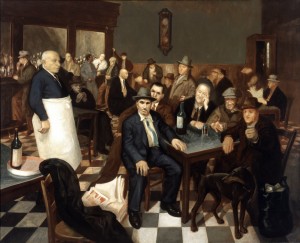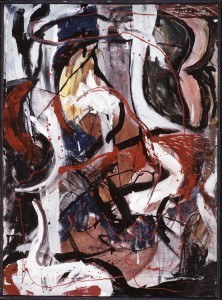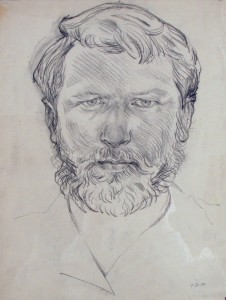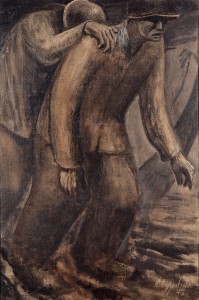FOR IMMEDIATE RELEASE:
Wednesday, April 16, 2014
Contact: Matthew Jackson, Harry Jackson Trust 307-587-5508 matt@harryjacksonstudios.com
Life’sWork, LLC 307-586-1503:
Jeff Mummery 307-899-204 gbmummery@gmail.com
Doug Hart 406-855-2823 hart@wbaccess.net
Work of iconic Wyoming artist Harry Jackson defies category
Fine art collectors, dealers and critics from across the country will be traveling to Cody, Wyo. in the coming weeks for a rare chance to evaluate a singular collection of distinctive work by an American master and 20th century icon.
Harry Jackson, an acclaimed painter and sculptor who began his career as a Marine combat artist, died three years ago at age 87. Jackson’s son, Matthew, has worked since then to catalog what he describes as “a lost treasure of the art world that has been hiding in plain sight for years.”
More than 5000 of Jackson’s sketches, sculptures, paintings and other works have been in storage and on display since 1980 at the artist’s studio and home in Cody and his foundry in Camaiore, Italy. Now, after three years working to assemble and survey 75 years of artwork, Jackson’s five grown children will be searching for a new home for the collection.
“Harry Jackson’s body of work can only be fully examined now that he has passed away and stopped creating,” said Matt Jackson, trustee of the Harry Jackson Trust. “The collection tells the full story of an unparalleled artist’s life, and it’s unlike any other.”
Matt Jackson said his father’s collection is “something the art world has never had the chance to fully examine, and now that he is absent, we’re learning so much more about his invaluable contribution to American art.”
Though he was best known as the pre-eminent Western artist of his generation, Jackson’s wide-ranging career defied category.
Jackson left his Chicago home at 14 for Wyoming, where he found work as a ranch hand. It was the start of a lifelong attachment to the region that would lead the New York Times to describe Jackson in a 2011 obituary as the “artist who captured the West.”
He enlisted in the Marines at 18 and was a World War II sketch artist during some of the bloodiest fighting in the Pacific. He was wounded in battles at Tarawa and Saipan, earning two Purple Hearts and suffering a traumatic brain injury that would result in seizures and mood disorders for the rest of his life.
Jackson was acclaimed as one of the great mid-century abstract expressionists, with LIFE Magazine in 1956 devoting eight pages to a profile that hailed him as an “American painter of surging talent and ambition.”
Clement Greenberg, the foremost art critic of the modernist era and principal champion of abstract expressionism, said Harry Jackson delivered “the best first show since Jackson Pollock’s.” In fact, Pollock was born in Cody, and Harry Jackson moved to the East Coast in 1947 where he sought out the pioneering painter to work with him, developing a close bond that would last until Pollock’s death in 1956.
Despite critical accolades and surging interest in—and market demand for—his work, Jackson turned his back on the New York modern art scene, and rededicated himself to mastering realism. Jackson went to Europe in 1954 to study the work of the Renaissance masters, and strove to incorporate modernist perspectives into a more classical approach. That duality of purpose would remain a driving force for the rest of his life, and define his approach to a career that sets Jackson apart from any other artist of his era.
Jackson was an iconoclast who repeatedly chose his own path, often defying critics and advisors, but always staying true to his own vision. Fiercely loyal to his friends, Jackson often painted or sculpted others he considered to be fellow mavericks.
That includes musician Bob Dylan, who sat for a portrait around the same time, in the mid 1960s, when the famed acoustic folk musician shocked the world by switching to electric guitar.
Jackson’s close friendship with actor John Wayne spanned several years, and in 1969 he created “The Marshal,” a sculpture for the cover of Time magazine of Wayne as Rooster Cogburn from the film “True Grit.”
Presidents Ronald Reagan, Gerald Ford and Lyndon Johnson all admired and displayed Jackson’s work, and gave his sculptures as gifts to foreign leaders.
Jackson was one of the first outsiders to move into Little Italy in New York after the war, and captured a powerful scene of immigrants in “The Italian Bar.” The large format realist painting captures moments of everyday life and neighborhood routine at The Mulberry Street Bar in Little Italy.
Time magazine art critic Gene Thornton said “The Italian Bar” served as “a reminder that serious figurative art was still possible in our time, and as an example of how it could be done.”
Thornton in 1981 called Jackson “one of the best-loved and most popular of living American artists” and “a figure of considerable historical importance.”
John Giarrizzo, artist and associate professor of art at Northwest College in Powell, Wyo., said “’The Italian Bar’ is one of the most important portrait paintings in American 20th century art.”
“Harry Jackson is the consummate American master,” Giarrizzo said.
The Harry Jackson Trust has selected Cody-based Life’sWork, LLC, lead by Doug Hart and Jeff Mummery, to present the collection to potential buyers.
“This is really an amazing and fascinating collection which you only come across once in a lifetime, and we wanted to be a part of this,” said Mummery, a Vietnam Special Forces veteran who was a close friend of Jackson’s. “I understood Harry on a level few people could relate to, and I connect with his work in the same way.”
Hart called Jackson “a gifted artist capable of many different expressions, and by all accounts, a real character.”
Hart is a longtime partner with Hall & Hall, the preeminent ranch brokerage firm in the western U.S.. “He was a 20th century icon who was a cowboy, soldier, expressionist, and a true romantic,” Hart said. “I’m privileged to represent his life’s work.”
For Matt Jackson and his siblings, seeing their father’s collection pass into new hands means turning a page. But it also offers a way to see Jackson’s work live on in a venue that does justice to an artist of his stature.
“The family would love to see the collection end up with an individual or institution that would fully appreciate Harry Jackson’s immense contribution to American art,” Matt Jackson said. “It’s important to us that his legacy continues to grow and thrive.”
In addition to Jackson’s original paintings, sculptures, sketches and other works, the collection contains hundreds of photos, home videos, tools, brushes, props, an extensive library of reference books and more than a half-century of business and personal records, including 120 volumes of personal journals.
For more information, visit www.harryjacksonstudios.com or contact Jeff Mummery at gbmummery@gmail.com or Douglas Hart at hart@wbaccess.net .
Images below for editorial use only.
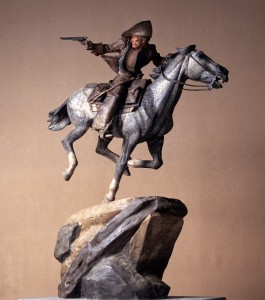
Pony Express by Harry Jackson 1984, copyright Harry Jackson Trust all rights reserved, photo by Marcello Bertoni
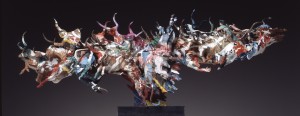
Cosmos, Painted by Harry Jackson 1996, copyright Harry Jackson Trust all rights reserved, photo by Marcello Bertoni
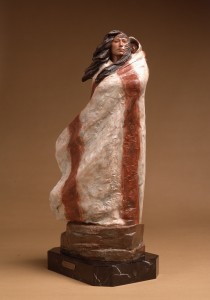
Sacagawea II, Painted by Harry Jackson, 1980, copyright by Harry Jackson Trust, all rights reserved, photo by Marcello Bertoni
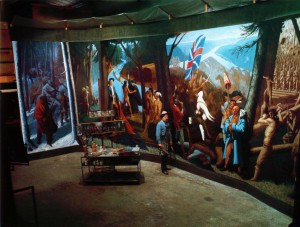
“River, Road and Point” begun 1965. Oil on Canvas 12′ x 56′. Jackson at work on the unfinished panels in his Camaiore studio. 1969
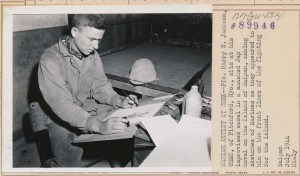
MARINE ARTIST AT WORK–Pfc. Harry A. Jackson, USMC, of Pitchfork, Wyo., sits at his improvised easel in a smashed Jap hovel on the island of Saipan, making sketches of Marines as they appeared to him on the front lines of the fighting for the island. Saipan, July 1944, Kiely
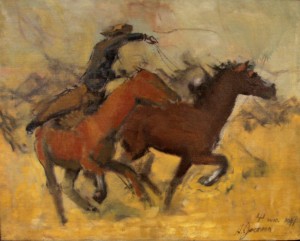
“Ropin the Stud”, 1941, Oil on canvas, copyright Harry Jackson Trust, all rights reserved. This was painted at the Pitchfork ranch in Meeteetse, WY before Jackson joined the Marines in 1942.

